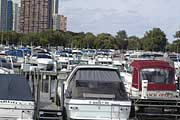
skip to content program navigation
| Learn more about these OCEAN and COASTAL RESEARCH areas... |
Water Resources and Hydrology
Quantity and quality of the Nation's water resources has been and will continue to be critically important to ensure, protection of life and property, economic well-being, and healthy coastal ecosystems. Moreover, in light of the alarming decline in water supplies in certain regions of the U.S. and world-wide, protecting and preserving vital water resources in the future will depend largely on sound management decisions supported by an in-depth, reliable scientific knowledge base. Key to this base is the full understanding of the hydrological cycle, the natural process by which water circulates among air, land, and water. Across NOAA Research, scientists are using hydrology, a scientific assessment of the volume, location and movement of water to build complex mathematical models to understand the intricacies of this vital cycle
A key component of this work is directed at the Great Lakes that represent one-fifth of the earth's supply of surface fresh water supply (95% of the U.S. supply). For three decades, the scientific products, services and expertise of the Great Lakes Environmental Research Laboratory (GLERL) have provided critical data and scientific insight that managers and policy makers need to make informed, cost-effective decisions in managing and protecting these vital resources. Additionally, research, extension, communications, and educational activities of the seven Great Lakes Sea Grant programs have provided a wide array of scientific products and expertise to a diverse and widespread community of Great Lakes user groups, managers and decision makers.
Elsewhere in the U.S., NOAA's's National Severe Storms Laboratory (NSSL), Atlantic Oceanographic and Meteorological Laboratory (AOML), Earth System Research Laboratory (ESRL), and Climate Program Office (CPO) are carrying out both large- and small-scale research projects focused on supporting informed hydrological understanding of water resources needed to ensure protection of life and property, economic heath, and sustained management and protection of these vital resources.
Great Lakes Environmental Research Laboratory (GLERL)
- Distributed
Large Basin Runoff Model
The DLBRM is an integrated, spatially distributed, physically-based water quality model to evaluate both agricultural non-point source loading from soil erosion, fertilizers, animal manure, and pesticides, and point source loadings at the watershed level. - Great Lakes Water Levels
- A network of Sea Grant colleges and programs working in partnership with government and the private sector to meet the changing needs of Americans living in the Great Lakes region
National Severe Storms Laboratory (NSSL)
- Quantitative Precipitation Estimation and Segregation Using Multiple
Sensors(QPESUMS)
The goal of QPESUMS is to research, develop, and deploy multisensor precipitation algorithms that are adaptable to different types of weather for flash flood, river flood, agricultural, and water resources management applications worldwide. Originally prototyped for use in the mountainous terrain of the southwest US, QPESUMS uses a unique blend of WSR-88D radar data, TDWR radar data, private sector C-band radar data, satellite imagery, lightning strikes, rain gauge data, surface and upper air observations, and numerical model output to estimate precipitation types and rates on a 1x1 km grid, every 5 minutes.- Algorithms developed to date include: 3-D Refelectivity Mosaic; Hybrid Scans; Brightband Identification; Convective-Stratiform Segregation; Calibration of Satellite by Radar; Verification Software; and Radar Calibration Diagnostics.
- QPESUMS deployment sites include: Arizona; Oklahoma; North and South Carolina; and Taiwan.
Atlantic Oceanographic and Meteorological Laboratory (AOML)
- Coastal Ocean Water Resources: Links With Terrestrial Freshwater Resources, Anthropogenic Influences and Climate Change
Earth System Research Laboratory (ESRL)
- Hydrometeorology Testbed (HMT) - improved hydrometeorological and hydrologic forecasts of precipitation and runoff by establishing and demonstrating a hydrometeorological testbed (HMT) in a vulnerable northern California watershed.
- Western Water Assessment (WWA) works within an evolving social context to increase the relevance and value of scientific information to improve decisionmaking leading to effective management of water resources in the western United States.
Climate Program Office (CPO)
- Climate Prediction Program for the Americas (CPPA)
CPPA seeks to improve intraseasonal to interannual climate predictions to improve climate-based hydrologic forecasting capabilities and decision support tools for water resource applications. - NOAA
Water Cycle Project
NOAA is in the beginning stage of developing a NOAA water cycle program to support CCRI (Climate Change Research Initiative) and USGCRP (U.S. Global Change Research Program) water cycle activities. The mission of the NOAA water cycle program is to improve the prediction and evaluation of water system risks.
|
|
NOAA Research programs that study Water Resources and Hydrology:
![]() Great
Lakes Environmental Research Laboratory
Great
Lakes Environmental Research Laboratory
![]() Great
Lakes Sea Grant Network
Great
Lakes Sea Grant Network
![]() National
Severe Storms Laboratory
National
Severe Storms Laboratory
![]() Atlantic
Oceanographic and Meteorological Laboratory
Atlantic
Oceanographic and Meteorological Laboratory
![]() Earth
System Research Laboratory
Earth
System Research Laboratory
![]() Climate
Program Office
Climate
Program Office




